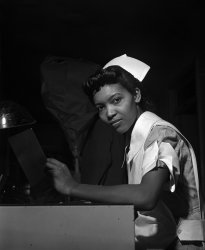
MAY CONTAIN NUTS

Search Shorpy
SHORPY ART

Framed or unframed, desk size to sofa size, printed by us in Arizona and Alabama since 2007. Explore now.
Join and Share
Ad-Free Shorpy
Shorpy is funded by you. Patreon contributors get an ad-free experience.
Learn more.

Recent comments
- If You’re Like Me, Never
- U.S.A.
- S&P
- 1940 Zenith radio model 6G601
- Quality goes in before the name goes on!
- Snazzy skirt
- Carbon Arc Lamps
- Illuminate us
- I remember it well
- I can't prove it
- Complicated then, forgotten now
- Bryan-Stevenson
- Skinny is as skinny does
- How do you rest in peace
- Riding the footboards
- Alas, hidden from view
- Baldwin Diesels
- Exclusive pump
- Bananas, Oysters and Smokey Joe
- Details, Details
- What's that building to the left of the tower?
- Coal Barges
- Bromo-Seltzer
- Inner harbor
- The Basin
- What a headache!
- Giant stepladder?
- Yeah, it was cold
- Love those coats
- Link & Pin Days Remnant
Member Photos
The Shorpy
Print Emporium
Print Emporium
Search Shorpy
Search results -- 30 results per page
- Welcome to Woodville: 1941
- ... Greene County, Georgia." Medium format acetate negative by Jack Delano for the Farm Security Administration. View full size.
Georgia ... Posted by Dave - 07/09/2021 - 10:22pm -
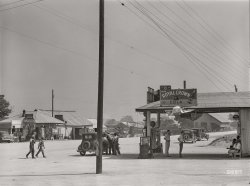
- Aerial Amarillo: 1943
- ... image posted here five years ago. 4x5 Kodachrome by Jack Delano. View full size.
Frank's creativity He sure comes up ... Posted by Dave - 08/01/2012 - 1:42pm -
![Aerial Amarillo: 1943 March 1943. "Amarillo, Texas, general view, South Tyler at SW 10th Avenue -- Santa Fe R.R. trip." This is the uncropped version of a smaller image posted here five years ago. 4x5 Kodachrome by Jack Delano. View full size.
Frank's creativityHe sure comes up with some imaginative and fascinating window displays.
Academy of Music & Art"Music Dancing Expression"
I thought that was illegal in Texas.
Old Stomping GroundsI spent the first six years of my life exactly here. Fortunately not quite old enough to be seen running away from home in my pedal car in Jack's picture, but old enough that some places well-depicted in that picture are among my vivid early memories.
No A/C !As a Californian I can't imagine living there in the summer.
Dear ShorpyAfter googlemapping I found the location, the photo was taken from the Santa Fe building(now the Potter County tax office) and looks S.W. The intersection you can actually see is SW 10th Ave and S. Harrison St. At least two of the buildings are still there.
View Larger Map
Skyspotting AmarilloIt's amazing to see a vibrant mixed 1940's neighborhood and the mostly barren industrial parkingscape of today.
Still in today's picture:
Amarillo Furniture Company now ABC Blueprints
Franks now Randy's Shoes
???R-A-WAY=Blackstone Cafe/Young Sushi
Academy of Music & Art now AKA Gaylynn's Bail Bonds and others?
Texaco Station now Vacant
Blue Bird Station now Qdesignworks
??? now Computer Shop
The older St. Mary's Cathedral School buildings on the far side of Elwood Park
. . . to put up a parking lot. Comparing this photo to the current view, it's striking how completely the homes near the center of the photo have been replaced by parking lots. And in each of the aerials in Google Earth since 1995, those lots are largely free of cars and people. It would be interesting to know how much of that transformation just happened on its own, and whether it was aided by scorched-earth urban renewal practices common in the 25 years after World War II. A December 1961 news article from the Amarillo Globe Times indicates that urban renewal was hadn't really begun yet.
Two lonely people!I can find a grand total of TWO people in the whole town! One is standing next to a car at the house with the turret directly above the Conoco gas station, and the other is waiting on the corner to the right of the white building with a dome in the center of the picture.
Wood Paneled SedanI am puzzled by the wood paneled sedan at the intersection across from the Conoco station. It looks to be a 1942 Buick, but to my knowledge, they did not make a wood paneled sedan. They did make a station wagon, but no sedan.
[Looks like a taxi - tterrace]
Many buildings still there!A view from the air, today:
http://binged.it/MNr0bT
And of course, the building this shot was likely taken from.
(The Gallery, Kodachromes, Jack Delano, Railroads)](https://www.shorpy.com/files/images/SHORPY_1a34723u.thumbnail.jpg)
- Fire-Chief: 1940
- ... on U.S. 1 (New York Avenue)." 35mm nitrate negative by Jack Delano. View full size.
Money in cans All those cans are worth well ... Posted by Dave - 09/12/2012 - 4:27pm -
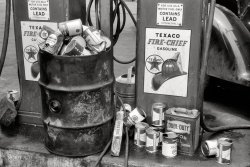
- Welcome to Cokeville: 1941
- ... Siloam, Greene County, Georgia." Medium format negative by Jack Delano for the Farm Security Administration. View full size.
The Corner ... Posted by Dave - 12/10/2018 - 10:17pm -
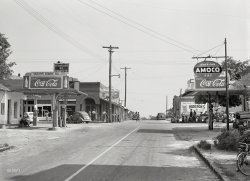
- Plains Grain: 1943
- ... between Amarillo, Texas, and Clovis, New Mexico." Photo by Jack Delano, Office of War Information. View full size.
"The Last ... Posted by Dave - 04/09/2013 - 10:13am -
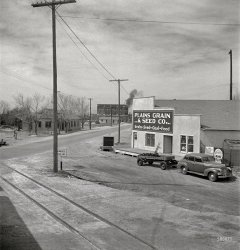
- The Milwaukee Road: 1943
- ... Chicago Union Station." Medium format nitrate negative by Jack Delano for the Office of War Information. View full size.
Precious ... Posted by Dave - 08/19/2013 - 2:15pm -
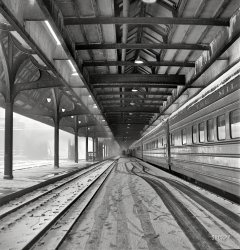
- It's Great: 1941
- ... near Rutland, Vermont." Medium format acetate negative by Jack Delano for the Farm Security Administration. View full size.
On the ... Posted by Dave - 04/16/2020 - 1:09pm -
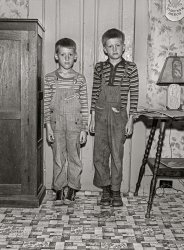
- Married, With Cows: 1940
- ... in Little Compton, Rhode Island." 35mm nitrate negative by Jack Delano. View full size.
His wife is a cutie! Look at that smile!
... Posted by Dave - 01/03/2013 - 7:42am -
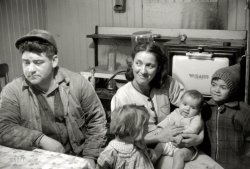
- Pampa Depot: 1943
- ... a town on the Atchison, Topeka & Santa Fe." Photo by Jack Delano, Office of War Information. View full size.
Grain Doors The ... Posted by Dave - 07/22/2013 - 8:09pm -
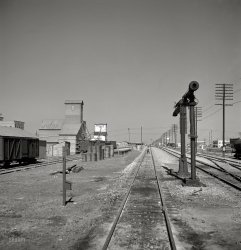
- Waiting for the Light: 1943
- ... the Atchison, Topeka & Santa Fe Railroad." Photo by Jack Delano. View full size.
Arm up? Isn't the signal up, which would ... Posted by Dave - 03/19/2013 - 11:35am -
![Waiting for the Light: 1943 March 1943. "Kiowa (vicinity), Kansas. Train waiting for a block signal along the Atchison, Topeka & Santa Fe Railroad." Photo by Jack Delano. View full size.
Arm up?Isn't the signal up, which would signal clear? Help me here, please?
Highball?I'm no expert on reading signal aspects, but I believe it's displaying a "proceed."
Time to goThis retired railroader says proceed thru the block at prescribed speed.
I believeit's the Atchison Topeka & Santa Fe RailWAY.
Clear!Yes, that signal is displaying "proceed".
Grade Crossing AheadThere's not much to go on in this photo for figuring out the exact location, but just beyond the second signal there appears to be a hard line crossing the tracks from left to right. That might be the now-abandoned Missouri Pacific branchline to Hardtner, KS. Assuming that Rt. 2 follows the old MP right of way (it has some very railroad-like broad curves to it), then this photo was taken near the intersection of Main Street and Railroad Avenue in Kiowa.
As for the signals. The square ends on both signals visible would indicate that they are interlocking signals (which fits with that being the MP crossing up ahead) and not a manual block (round end) or automatic block (pointed end) signal. The other two posters (at this writing) are correct, the signals are set to clear. So, the description given is just writer's license.
PuzzlesPhare Pleigh makes good observations. There are more questions in my mind, though:
1. The far signal, on the pole, is on this side of the crossing - that is, it is beyond the crossing, and so does not govern moves over the crossing.
2. There is only one track at the far signal, so only one route should be possible. However, both signals are showing clear, which would mean conflicting (opposing) routes - which should not be possible.
3. The near switch is in front of the cantilever signal, so it is "outside" the interlocking; the signal does not govern moves over this switch. The second switch is "inside" the interlocking, and is protected by the signals. I would have expected to see another signal governing moves from this track, quite possibly a dwarf; I can't see one in the picture.
4. The far switch *should* be set for the other track, but again I can't see the position in this photo.
An interesting picture. And the train is probably waiting for a clear signal, since the signal on the cantilever is clear for a different train (I think).
Aspect not litI agree...Dave, we need a zoomed in view of the switch points in the background.
Also, I also will echo that the arms of the semaphores are in the clear position, however, I would have expected, even in bright daylight at this angle, to be seeing the clear light through the semaphore lens. It appears to be dark or just a little light (probably from the background) getting through it. With the bulb on the other side it should be brighter than it is.
edit: After tterrace's generous post of the zoomed photo, can we throw a monkey wrench into the comments and possibly say that the level crossing in the distance may not be a diamond but a vehicle crossing? I ask this as us railroaders would expect to see a signal protecting the other side of the crossing. Yeah, I don't see any crossing warning signs on either side of the main to warn vehicle traffic, nor any telegraph/phone lines paralleling the line, but I also don't see any bulky diamond hardware sticking out of the side of the mains rails as I do with the guard rail and switch point areas. This makes me believe this is a road crossing.
Also noticed that the locomotive probably is sitting on the main as there is a spring frog on the left main rail with the spring mechanics on both sides of the left rail and a visible flange gap on rail the locomotive is on.
[This is as big as it gets. - tterrace]
TrainspottedIt is a "Clear" Signal but you will notice:
1. It is on a cantilever station rather than on a pole similar to the signal a little farther down the track. That would imply that the signal is governing one of the tracks diverging off to the left. If it were for the track on which the locomotive stands it would likely also be on the pole. (Yes, I understand ATSF did use cantilever signals right next to the track they are governing).
2. The aforementioned pole signal is also showing a clear indication. Unless the signal system is malfunctioning it could not display this aspect to the track on which the locomotive is standing (not to mention the track that has the clear signal on the cantilever).
3. The answer seems to be that the locomotive is on an auxiliary track and that the signals govern the two tracks diverging to the left. The cantilever signal probably also governs the crossing at grade a short distance ahead.
Thanks!For all the info regarding how signals worked and how to understand the sources. A very intricate business indeed.
Engine LocationOk.. I'm going to go out on a limb and try to figure where this was taken. According to the shadows it appears we are travelling to the west. On the left side, marked by the row of telephone poles is Route 2 which runs between Attica, Ks and Kiowa, Ks. Very far ahead on the right hand side is, what looks like, a grain elevator. I think that is the grain elevator at Hazleton, Ks. The roads I cannot identify exactly because I can't determine distance by a photograph. There is a railroad cross marking immediately to the right. It doesn't look well travelled so, I will guess, it leads into a field. They still have those today. The next major road just beyond the signals could be Minco Road or Tri-City Road which is closer to Hazleton. I don't know of any other grain elevators between Attica and Kiowa. So, I think we are somewhere within a mile or two east of Hazleton, KS.
Another thoughtIt would seem likely that for one reason or another, the semaphore system was not in service at the moment this picture was taken. Is it possible the ATSF was in the process of installing the signal hardware, but had not yet put the system into service? Up until about 10 years ago the old Monon line (now abandoned) between New Albany, Indiana and Bedford, Indiana was controlled by semaphore indication. At some point shortly afterward the signal system was taken out of service and an order to that effect was issued. Train crews were instructed by the order to disregard the semaphores and be governed by DTC. I believe there are pictures on the web of what appear to be CP and INRD trains running “stop” semaphore indications in that territory. Regarding the Shorpy image, my guess is the train was running with timetable and train orders, waiting for an opposing train to clear the main at the far switch.
Why I love Shorpy!It's wonderful, the level of engagement we get, as folks chime in with these great details; always fascinating!
I'm just surprised no one has (yet!) counted rivets and kinks in lube lines and told us which locomotive this is.
I capitulatePiyer, I think you are right. I asked a good engineer friend of mine who basically said the same thing.
{Jim said} There are railroad diamonds that have no protection whatsoever; no interlocking signals, no manual gates, no stop signs. After viewing some aerial maps I've changed my mind and think that it is an unprotected railroad diamond crossing which no longer exists.
My guess of the track layout, judging from the placement of the signals, is that the mainline comes from the distance and continues on the farthest-to-the-left track visible in front of the steamer. The facing semaphore signal is to the left of center of the steamer's track and beyond the points of the closest switch and governs, I think, the facing movements on the far left track.
In the Bing aerial photo I've marked **PIYER, his attachment was EXACTLY the same place you linked!** what I think is the Santa Fe mainline (and the diverging branch at the wye) in blue, the yard or auxiliary track that the steamer is on in green and the middle track, which might be the Kiowa Siding, in yellow. I'm just assuming that the railroad crossing at the diamond, which I've marked in red, is another railroad and not just another Santa Fe line because of the overall track layout in the area.
And yes Dbell, I agree, that is one of the reasons I keep coming back here, the level of expertise and civility of the folks that comment here makes this just awesome.
Flat Pair SignalsThe masts of both of the signals have number plates, indicating they are Permissive Signals rather than Absloute Signals, and thus are block signals rather than part of an interlocking system. Unlike most other roads, on the Santa Fe square end signal blades were used on block signals.
The question then remains as to why the signal to the left would be showing a clear block when we know there's a train, as we are on it.
Close examination of a zoomed image shows that the points of the switch adjacent to that signal are aligned for the siding. The signal is showing that the route for which the turnout is lined, that is, the siding, is clear.
The signal in front of our engine also shows clear because we can proceed through the spring switch.
This was a signal system in wide use on sidings on the ATSF, which they called Flat Pair Signals.
An answer???Looking at BING, which is nice enough to include abandoned rail lines, I see that the MP line crossed the Santa Fe further south than I had original thought.
Flipping that map (http://binged.it/11eaawr) so that south is up and north is down, I think we are pointed in the same direction as the locomotive. Much has, obviously, changed over the years, but it would now seem that the interlocking signals aren't for the crossing but for the south leg of the Santa Fe's wye / branchline junction. If you allow that the yard might have originally been on the opposite side of the mainline so as to serve both main and branch lines, then this can fit with the image here.
As for the lack of signals at the grade crossing...
The line from Kiowa to Hardtner is / was (abd. 2002) the Kiowa, Hardtner & Pacific Railway from birth to abandonment, and merely operated by the MP. It is conceivable that the KH&P was dark territory and that trains had to stop clear of the crossing and get permission to cross from the Santa Fe dispatcher - a cheaper option than a manned interlocking, the expense of which, as the second railroad on the scene, would have typically fallen on them.
Final puzzle pieceFrom my timetable collection, I dug up Missouri Pacific system timetable #18 - October 25, 1981. According to this, the Hardtner branch crossed the Santa Fe a total of 7 times between Hardtner Jct. (Wichita, KS) and Kiowa in route to Hardtner. These crossings were protected by (n to s): a gate, a gate, a manual interlocking, a stop sign, a stop sign, a gate, and a manual interlocking. The last one presumably being the crossing we are looking at here.
Locomotive: Class 4000 Mikado(2-8-2), one of a group of 101 (4000 to 4100) built by Baldwin between 1921 and 1926 (Maybe there's another photo from Mr Delano from this set that shows the specific number?) and scrapped between 1950 and 1954. This is based on the "40" that I can see on the sand dome.
[Here you go. - tterrace]
Colour?I know nothing about trains, but I do know the train community is *very* specific about making sure train colours are correct especially in black and white photos. Anyone got a colour reference for the train?
More photos & cluesHere are several other helpful photos from this set. The opposite side view shows more of the track layout and another has the engine detail.
Piyer, I'd say you're right on target in the BING photo! The LOC photos DO show the yard on the wye side of the main. Presumably as train lengths increased, the sidings couldn't be lengthened on the town side of the tracks, so the whole shebang was flip-flopped. Topo maps show remnants of a road in that location going from the present adjacent farmhouse across the tracks to the former airstrip, and a curved track bridging the wye ends (that scar still visible).
That is definitely a crossing with another railroad. Look at the height of the telephone poles on both sides. In 1943, highways didn't get such vertical clearances, plus, there are tie ends barely visible "behind" the far signal. There are also 2 vertical "somethings" just to the right of the cantilever mast (one near each track).
In the cab window view, the far switch points are definitely reversed toward the wye (and apparently the cantilever is reflecting that route). That much just makes sense. (all this more visible in the massive LOC TIFF images)
Mystery solved?
ATSF 4097According to information available to me, ATSF 4097 was built by Baldwin Locomotive Works in 1926, construction number 59398.
For those not familiar with railroad terminology, I have written out the following information in long form. I recognize many of these details will be of more significance to locomotive historians who would be satisfied with the usual technical shorthand.
Principle dimensions:
cylinders: 27 diameter, 32 stroke, in inches
driving wheel diameter: 63 inches
working pressure: 200 pounds per square inch
calculated tractive effort: 63,000 pounds*
weight on drive wheels: 260,200 pounds
total locomotive weight: 342,000 pounds
tender capacity: 5,000 gallons oil; 15,000 gallons water
tender weight, fully loaded: 298,600 pounds
total wheelbase, engine and tender: 79 feet, 1.875 inches
total length over coupler pulling faces: 89 feet, 9 inches
Like all locomotives in the '4000' Class, it was built with a Schmidt superheater, Walschaert valve gear, Elesco feedwater heater (except 4007) and Delta trailing truck.
It was built as an oil-burner.
It was sold for scrap to Commercial Metals Co. on 27 January 1956.
GENERAL NOTES: Dimensions given are typical for the 1926 Baldwin-built locomotives (4086-4100) and do not necessarily apply to any specific locomotive at a specific time. It would be surprising if any locomotive matched the dimensions exactly even when new. In particular, recorded weights could vary significantly between rolling the same locomotive off and then back onto a scale. Weight on drive wheels varied with spring tension (in the suspension system) and changed with wear or simply shop setting.
*-The dimension seemingly of most interest to railfans is also the least relevant -- that of calculated tractive effort (CTE, usually shortened to tractive effort=TE). As the name implies, it is a theoretical calculation of the maximum amount of force available to be applied at the driving wheels. It is, at best, vaguely accurate for comparison purposes between locomotive classes over a given profile. Although some railroads reported CTE down to the last pound, any calculation more precise than the nearest thousand pounds was pure fiction. In fact, the ONLY way of determining what a locomotive can haul is by controlled road tests using a dynamometer car.
Those already interested in the ATSF will no doubt already know my sources, primarily S. R. Wood and E. D. Worley. I can provide more detail if wanted.
(The Gallery, Jack Delano, Railroads)](https://www.shorpy.com/files/images/SHORPY_8d26661a.thumbnail.jpg)
- The Sheltering Sky: 1943
- ... Mexico. View full size. 4x5 Kodachrome transparency by Jack Delano for the Office of War Information.
I walk the line Up until the ... Posted by Dave - 08/30/2012 - 3:28pm -
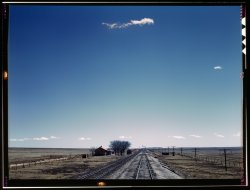
- Bensenville: 1943
- ... track. View full size. 4x5 Kodachrome transparency by Jack Delano for the Office of War Information.
Working on the Railroad I've ... Posted by Dave - 08/10/2012 - 5:38pm -
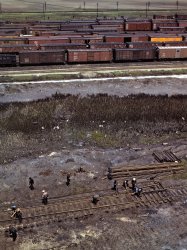
- The Eggs and I: 1940
- ... a bulldozer at an Army camp nearby." Acetate negative by Jack Delano for the Farm Security Administration. View full size.
Make mine ... Posted by Dave - 09/29/2019 - 6:56pm -
![The Eggs and I: 1940 December 1940. "Mrs. Richard Carter, poultry farmer of Middleboro, Massachusetts. She runs the business of one thousand poulets while her husband drives a bulldozer at an Army camp nearby." Acetate negative by Jack Delano for the Farm Security Administration. View full size.
Make mine scrambled ...... with buttery grits, crispy bacon, and a hot biscuit. Oh and I'll have a pair of those Knock-Out shoes in size nine.
Not all in one basket?Check.
When your day can't end soon enough.Egg scale. Small, Medium, Large. A boring job for sure.
HOW MUCH DOES IT WEIGH?EGGzactly 2.1 oz. (That's what one of my Grade A large eggs weighs)
Zenith egg grader... I suppose.
And under her breath you can hear sayingL, L, M, XL, S, XL, M, omelette, M, M, L, omelette, and so on.
I'm Totally Floored!As boring as this mundane task must be, I'm certain that the flooring will keep her wide awake! Any of you 'colorizers' out there up to the challenge?!?
Mille chickensPoulets? Is this a flourish or an old American usage?
[Perhaps Ukrainian-American. - Dave]
Nice rugThat's a really nice rug. With that, the wallpaper and the curtains in the window, it doesn't look like a coop. They must move the ready eggs to a different room, barn or house to do the weighing and sorting. Since she's wearing short sleeves in December in Massachusetts then it's probably well heated also. I wonder if she moves the eggs from the barn or if they had a helper.
[That's a linoleum rug. - Dave]
(The Gallery, Agriculture, Jack Delano)](https://www.shorpy.com/files/images/SHORPY-8c04337a.thumbnail.jpg)
- Paper Pusher: 1941
- ... Corporation mill." Medium-format nitrate negative by Jack Delano. View full size.
Working Man Except for the fact that he's ... Posted by Dave - 03/10/2010 - 7:50pm -
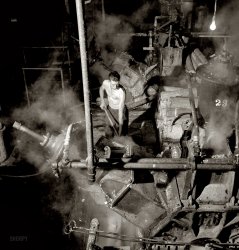
- Winter Light: 1941
- ... plant in Midland, Pennsylvania." Medium format negative by Jack Delano for the Farm Security Administration. View full size.
Speedy ... Posted by Dave - 12/22/2018 - 11:05am -
![Winter Light: 1941 January 1941. "At the steel plant in Midland, Pennsylvania." Medium format negative by Jack Delano for the Farm Security Administration. View full size.
Speedy Pizza?
Red LightThe traffic light looks the same in this monochrome photograph as they do in real life to my colourblind eyes.
[It could also be a green light. - Dave]
Train in the backgroundI have the NYC gondola and PRR boxcar. Only in the smaller Lionel electric trains version.
Brrrr ...This is one of those pictures that make you feel cold just looking at it.
Ice Ice BabyI'm hoping that the baby carriage is unoccupied.
Stop LightIt's RED. as the rhyme I taught my children says: the light on top means STOP.
[Back in the day, green was the top light on many a stoplight. - Dave]
If you say so.
Green top, red bottomAs seen here.
Stoplights Part 2Dave's right, Phaedrus, because back before 1950, there were a number of different types of traffic control devices until they were standardized. I worked for the local County Highway Department and according to the Seeley Book of Standards (our office Bible), there were (among others) red/green (no yellow) and the type that Dave is talking about. On the main road was (top down) red/yellow/green and on the side road, green/yellow/red with the lenses being illuminated by a common bulb at each level.
Stark, grim, and beautiful Why do I get the feeling that this guy is going to find his way into a taproom sooner or later.
(The Gallery, Factories, Jack Delano, Railroads)](https://www.shorpy.com/files/images/SHORPY-8c04475a.thumbnail.jpg)
- I.G.A.: 1941
- ... store in Hinesburg, Vermont." Medium format negative by Jack Delano for the Farm Security Administration. View full size.
The Dors ... Posted by Dave - 01/08/2019 - 8:11pm -
![I.G.A.: 1941 August 1941. "General store in Hinesburg, Vermont." Medium format negative by Jack Delano for the Farm Security Administration. View full size.
The Dors of Perception1936 Ford Fordor Touring Sedan. Yes, Ford spelled it Fordor & Tudor.
Somewhat changed
Orthochromatic film?The sign at the top, carefully lit with a half-dozen lights but without seeming to have any words or images could conceivably have been caused by blue paint on a white background, if it was photographed by orthochromatic film, which was still sometimes used at this time.
[There's another, simpler, explanation. - Dave]
IGA's were everywhereI remember when IGA stores were in almost every little town. When I grew up in Loomis, Nebraska, the IGA was a block from our house and up until 1975 we made our weekly grocery trips there. You could get an after-school pop there. It closed in the early 90s.
The Orthochromatic BluesIf it was orthochromatic film the blue sky would have been washed out.
Car IDs1936 Ford; 1929 Essex
The Inevitable CarOf course, there's a Subaru passing in the modern streetview image.
Hinesburg is an increasingly suburban area but still has quite a bit of working farmland for how close to Burlington it is.
(The Gallery, Gas Stations, Jack Delano, Stores & Markets)](https://www.shorpy.com/files/images/SHORPY-8c06847a.thumbnail.jpg)
- Mrs. Information: 1943
- ... all over the country at the Union Station." Photo by Jack Delano, Office of War Information. View full size.
IT 1943 Must be a ... Posted by Dave - 04/26/2013 - 9:36am -
![Mrs. Information: 1943 January 1943. Chicago, Illinois. "Mrs. Marie Griffith, manager of the information room, at one of the boards listing rates to points all over the country at the Union Station." Photo by Jack Delano, Office of War Information. View full size.
IT 1943Must be a real pain when a new city pops up in between two older ones.
Wow!This message board makes the code machine shown here earlier
look like child's play!
Thanks to InflationChicago to San Antonio in 1943: $40.16; this is equal to $540.36 in 2013 dollars.
[Adult fare on Amtrak's Texas Eagle from Chicago to San Antonio is $256. - Dave]
RatesOK, I understand OW and RT, 1stCl and Coach, and the 3-Mo period for an open RT ticket. But, what's "FURLO"? And why is it set at 90 days, rather than the nearly identical 3-Mo?
Also, curious why about the way the classes were split across the board. Looks like OW-1st, OW-Coach, then RT-Coach, followed by RT-1st, judging by the different heading colors and the prices.
Rail historians? Anyone?
Military fares?I'm guessing FURLO was for special military furlough fares, given that this is 1943.
These are strictly railroad fares--if you wanted a sleeper, you'd need to pay the first class rate plus the Pullman Company's charge for the room. And they seem to be just fares out of Union Station, so the rate to Davenport, IA is most likely on the Milwaukee Road via Savanna, IL. Most travelers would just walk a few blocks over to La Salle Street Station and take a Rock Island Lines train direct to Davenport.
Furlough fares in WWIIFrom 1940 until early 1947, a special rate was charged to members of the armed forces travelling at their own expense. It was good in coaches only, and priced at 1.25 cents per mile with a return limit of 30 days, later extended to 90 days. I note that the "FURLO" fares (listed in the fifth column) from Chicago to Dallas, and to Houston, were 50.54 percent of the fares in the fourth column.
Furlough FaresFurlough fares were a permanent thing. Amtrak continued to offer a 25% active-duty military discount until well into the 1980s, at least, IIRC, heck they might still have it. Reservists and National Guardsmen were not eligible unless they produced orders showing they were in an active duty period. A green I.D. card was normally required.
Also well into the Amtrak era were clergy fares, and discounts for blind passengers, either traveling alone or with a human or canine escort. These were a real pain for agents, since they continued to be administered by regional "bureaus" which issued coupon books, and some of them had odd discount rates, like 10.5%, etc.
In pre-computer days, all tariffs, passenger and freight, express and baggage, for all modes, were VERY complicated.
Similar to Military Standby in the 60sWhen I was in the Navy in the 60s I could travel on leave with the airlines as a military standby passenger for a reduced rate. It was strictly space available but it usually worked quite well for me. This was probably an outgrowth of the tradition of the FURLO fares from the WW2 era. I don't think it is available anymore. It probably wouldn't work well now since most flights today are usually overbooked.
A dusty jobI note that Mrs. Information is wearing a duster to protect her dress from the chalk dust. Also, did the train fares really change so frequently that they needed to be recorded in this manner?
1956 electionI remember that on election night in 1956 the major networks were tabulating the results of the Ike-Adlai presidential election in a similar manner. When I was in the Air Force in the late '60s we still tracked critical equipment and circuit status by hand in Maintenance Control at Ramstein Air Base by hand, though we used grease pencils on Plexiglass by then. We've come a long way.
An inefficient systemAnd the railroads knew it, even at that early date. By the late 1940's the first punchcard ticketing data systems were being experimented with to eliminate boards like this. Unfortunately, they wouldn't need to utilize and improve such new technology for long. These days Amtrak could probably store all of its destinations and rates on a Commodore 64, so sparse and limited is its service.
PreciseI'm astounded at the quality of the penmanship. Maybe at the start of a shift but after a long stretch, you'd start to 'slur' your writing. Impressive. No erasers = no mistakes?
Up and down the boardStock brokerage firms had wall-to-wall boards with current up-to-the-moment stock prices, at least into the 1960s. Bookie joints also had boards.
Nice to see the old home town on ShorpyEven if it's only written in chalk. Hempstead, Texas.
In the lady's shadow - the town where I was born, Hugo, OK. The town where I grew up, Idabel, OK, is not listed, but my mother has often spoken of riding the train between Idabel and Hugo.
(The Gallery, Chicago, Jack Delano, Railroads)](https://www.shorpy.com/files/images/SHORPY_8d24991a.thumbnail.jpg)
- Stitchcraft: 1941
- ... the needlework factory." Medium format acetate negative by Jack Delano. View full size.
Such elegant ladies So well turned out, all ... Posted by Dave - 03/05/2019 - 9:57pm -
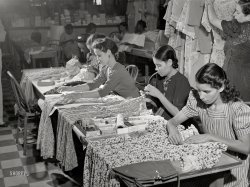
- Trainlight: 1943
- ... trip." View full size. 4x5 Kodachrome transparency by Jack Delano, who seems to have been among the earliest photographers of light trails ... Posted by Dave - 08/30/2012 - 3:30pm -
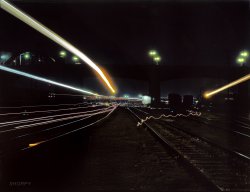
- Lunch-Pail Pals: 1941
- ... school near Fairfield, Vermont." Medium format negative by Jack Delano. View full size.
Stylin' the new matching wingtips ... Posted by Dave - 03/01/2019 - 9:54pm -
![Lunch-Pail Pals: 1941 September 1941. "Two of the Gaynor boys walking to school near Fairfield, Vermont." Medium format negative by Jack Delano. View full size.
Stylin' the new matching wingtipsNothing better than that feeling of your new school clothes and shoes. They each have swag for sure.
Photogenic familyThe Gaynor boys and their little sister Carolyn are ridiculously photogenic. These look to be the two oldest, Robert (10), and John (7). They could have been child models.
Purpose-made or repurposed?As I look at the anchors for the bails and the general shape and size of both tins, I wonder: are these purpose-made or are they cleaned and repurposed gallon paint tins?
[Those are Swift's lard buckets. - Dave]
Well, there you go. Lard was never favoured in my family as a shortening, and lard buckets were outside my experience.
A Question about KnickersWhen did knickers cease to be common apparel among boys? My sense is that they were gone or mostly gone by the late '40s, but I didn't arrive until the '50s. Someone who was there: please clue me in.
Air of MysteryWhen I was little, I read Laura Ingalls Wilder's "Farmer Boy" and I was entranced by the idea of a "lunch pail". How would that differ from my own lunch box? Would it be bigger? Would food stay hot longer? And if I had one, how could I convince my mother to put "bread-and-butter and sausage, doughnuts and apples, and four delicious apple-turnovers, their plump crusts filled with melting slices of apple and spicy brown juice" in it instead of celery, carrots and a sandwich.
Then I got a bit older and realized it was just a bucket.
I've decided that this is charming. Not the usual Jack Delano. The boy on the left has the shy smile of someone who doesn't live in Midland PA.
KnickersI never wore knickers, and don't recall others wearing them. I was born in 1932.
(The Gallery, Jack Delano, Kids, Rural America)](https://www.shorpy.com/files/images/SHORPY-8c06950a.thumbnail.jpg)
- Saturday Shoppers: 1941
- ... last seen here . Medium format acetate negative by Jack Delano. View full size.
Bust stop? Is the overhang over "Cola" a ... Posted by Dave - 04/10/2020 - 8:31pm -
![Saturday Shoppers: 1941 November 1941. "View of Greensboro, Greene County, Georgia, on a Saturday afternoon." The street corner last seen here. Medium format acetate negative by Jack Delano. View full size.
Bust stop?Is the overhang over "Cola" a bust stop or shoeshine post or ???
[Pray tell, what is a "bust" stop? - Dave]
Western AutoThat signage would work well even today. I could not help but notice, as well, how neatly dressed the people are.
Everyone neatly dressed... and one barefoot little boy.
[Two, actually. - Dave]
Coke muralWhat a beauty. If you follow the link in Dave’s caption to the earlier post (Nov. 11, 2018), we get an even better view, close up. The bottle on the right is a masterpiece: the light gleaming on the vertical facets above the lettering on the bottle, the raised Coca-Cola lettering itself, the crimps of the bottlecap – all this is achieved with paint on brick. I applaud the skilled tradesman of yesteryear.
Barefoot in the crosswalkGrocery stores like the one on the corner were very common back in the day."Barefoot boys! Watch out for hazards!" I've never seen a sign like the one under the traffic signal. "No turns."
Hasn’t changed a lotI ride through this intersection often on my way to Athens. The buildings haven’t changed that much, but I rarely see this many well-dressed people.
BrrrBarefoot in November. His mama shouldn't have let him do that. She looks like she could afford a pair of shoes.
It's like Truman always said --The bust stops here.
Re: Bust stopA bust stop is what happens when someone has to slam on their brakes upon seeing a Jane Russell lookalike at the crosswalk.
About "No Turns"Even I was curious about the "No Turn" sign below the signal posted by jimmylee42. What the sign really states is "No U Turns." The U is there but not as noticeable in a B/W photo. This one just might be missed today while driving because we are so used to seeing so many large print, brightly colored signs.
BustedToo funny, Dave. Have you tried typing bus stop after a few beers on lockdown?
here's a good explanation of bust stop. https://youtu.be/NBLZ2PBJHjg
Be well,
Harold O.
Los Angeles
(The Gallery, Jack Delano, Small Towns, Stores & Markets)](https://www.shorpy.com/files/images/SHORPY-8c35447a.thumbnail.jpg)
- Coaling: 1942
- ... yards. View full size. 4x5 Kodachrome transparency by Jack Delano, Office of War Information.
Coaling 1942 What a beautiful image. ... Posted by Dave - 07/20/2012 - 3:45pm -
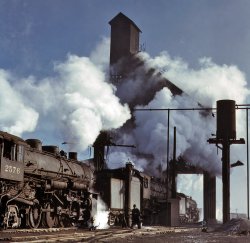
- Water Street, Night: 1943
- ... Central R.R., Chicago." 4x5 Kodachrome transparency by Jack Delano. View full size.
Amazing This is all condo's now I believe ... Posted by Dave - 05/09/2017 - 9:21am -
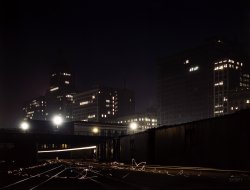
- Working Lunch: 1943
- ... and E.H. Albrecht." Medium-format nitrate negative by Jack Delano. View full size.
Leg Ties That's one way of keeping a cold ... Posted by Dave - 07/15/2009 - 7:43am -
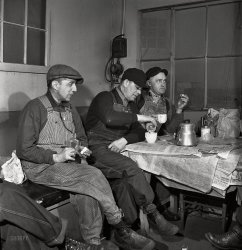
- Eastbound Freight: 1943
- ... and Clovis, New Mexico." Medium-format negative by Jack Delano for the Office of War Information. View full size.
Safety first ... Posted by Dave - 06/13/2015 - 11:21am -
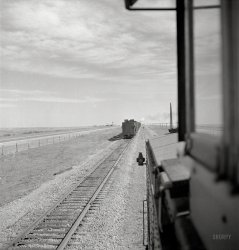
- Boxcar Brown: 1942
- ... color-coordinate your caboose. Kodachrome transparency by Jack Delano for the Office of War Information. View full size.
I confess ... Posted by Dave - 11/22/2016 - 10:46am -
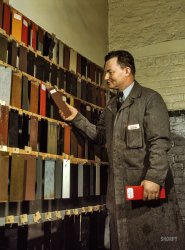
- The Night Porter: 1942
- ... 'Capitol Limited' bound for Chicago." Acetate negative by Jack Delano. View full size.
Sam McGee Robert Service wrote of a porter ... Posted by Dave - 03/18/2020 - 12:32am -
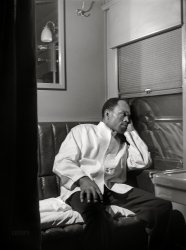
- Hulett Unloader: 1943
- ... View full size. 4x5 Kodachrome transparency by Jack Delano.
Hulett Unloaders More information here .
(The Gallery, ... Posted by Dave - 08/30/2012 - 2:00pm -
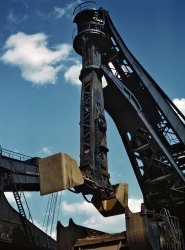
- Off Track: 1943
- ... Topeka & Santa Fe locomotive shops." Photo by Jack Delano. View full size.
In a Rut - Not! Wow! Awesome! Thanks for ... Posted by Dave - 02/05/2014 - 6:31pm -
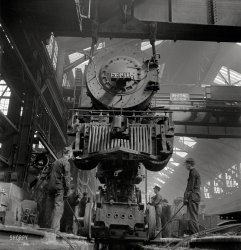
- Student Nurse: 1942
- ... at the Youngstown Sheet and Tube Company. Photo by Jack Delano, March, 1942. View full size.
A detailed history… …of ... Posted by Ken - 08/08/2012 - 8:19pm -
